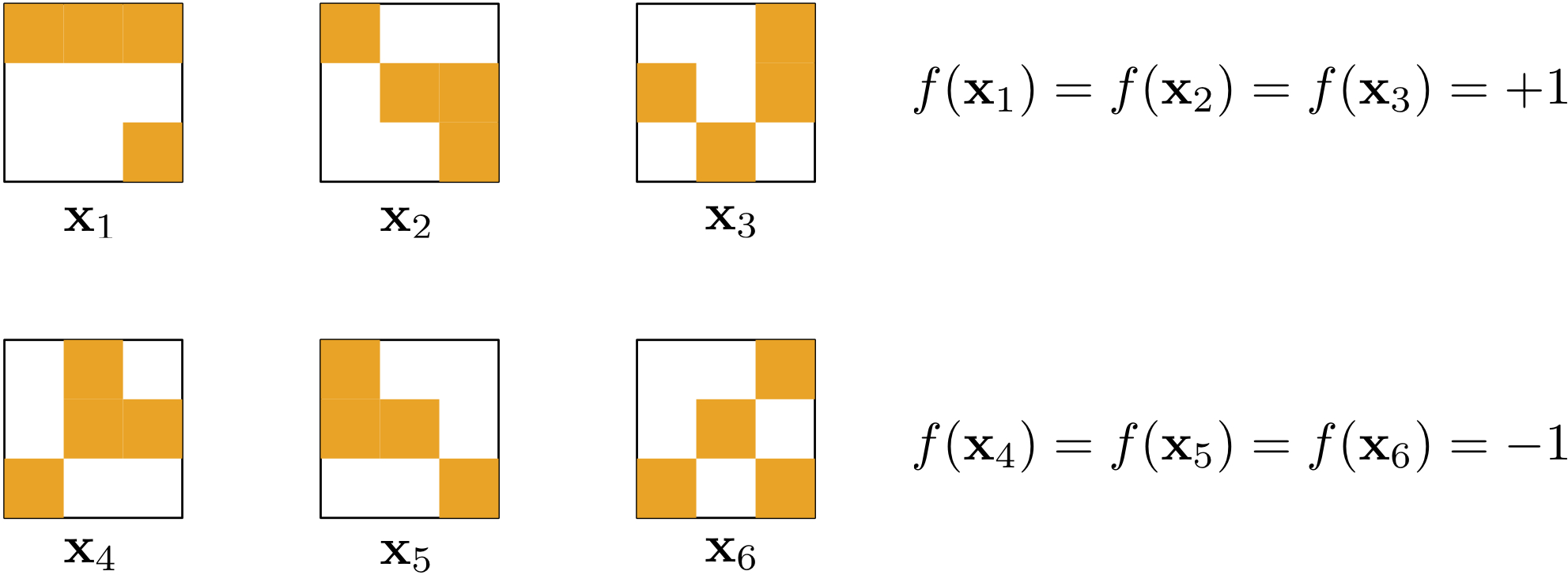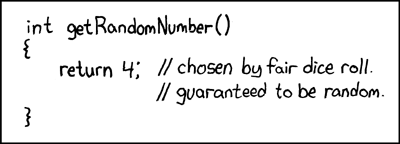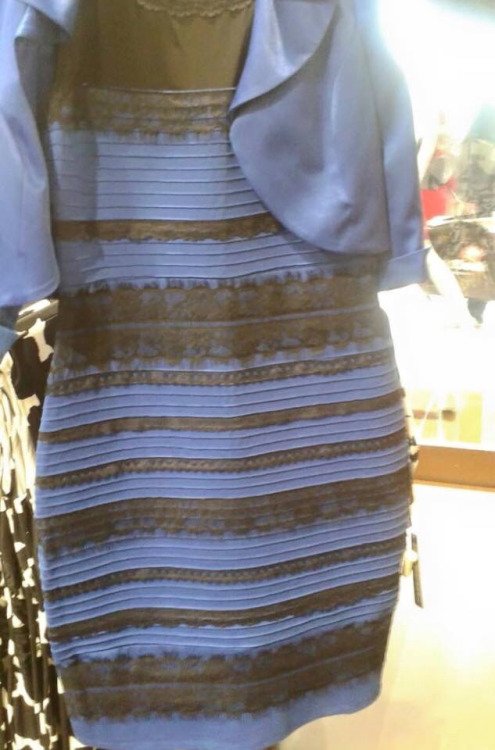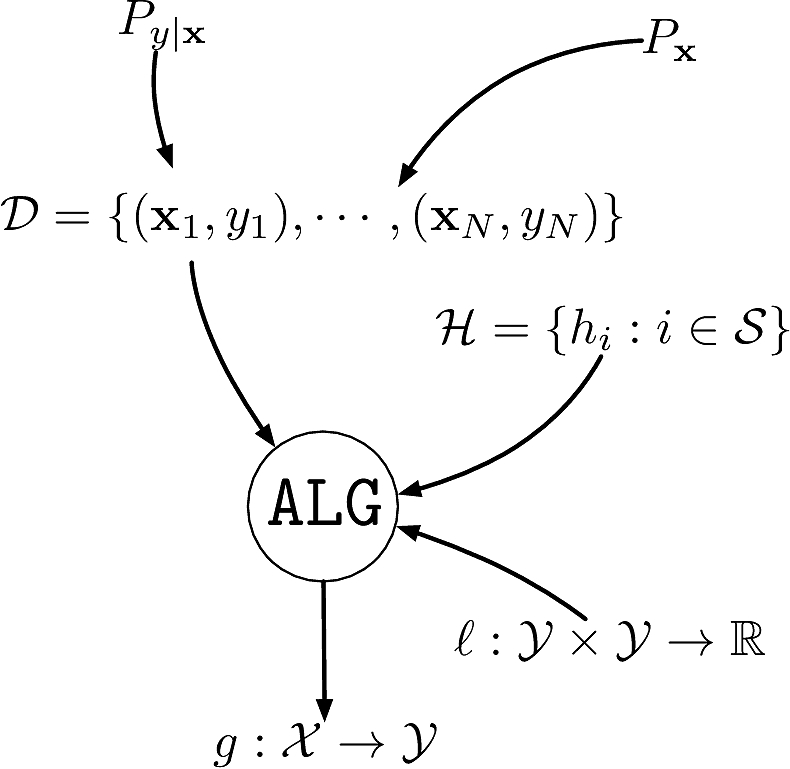The supervised learning problem
Matthieu R Bloch
May 11, 2020
Types of learning
- Supervised learning
- Given input data \(\{\bfx_i\}_{i=1}^N\) representing observation of phenomenon
- Given output data \(\{y_i\}_{i=1}^N\) representing “label” attached to observation
- Goal is to identify input-output relationship from training data \(\{(\bfx_i,y_i)\}_{i=1}^N\) and generalize
- Unsupervised learning
- Given input data \(\{\bfx_i\}_{i=1}^N\) representing observation of phenomenon
- No output data!
- Goal is to understand structure, or infer some characteristic of underlying probability distribution
- Other types of learning
- semi-supervised learning
- active learning
- online learning
- reinforcement learning
- transfer learning
- imitation learning
Components of supervised machine learning

- An unknown function \(f:\calX\to\calY:\bfx\mapsto y=f(\bfx)\) to learn
- The formula to distinguish cats from dogs
- A dataset \(\calD\eqdef\{(\bfx_1,y_1),\cdots,(\bfx_N,y_N)\}\)
- \(\bfx_i\in\calX\eqdef\bbR^d\): picture of cat/dog
- \(y_i\in\calY\eqdef\bbR\): the corresponding label cat/dog
- A set of hypotheses \(\calH\) as to what the function could be
- Example: deep neural nets with AlexNet architecture
- An algorithm \(\texttt{ALG}\) to find the best \(h\in\calH\) that explains \(f\)
- Terminology:
- \(\calY=\bbR\): regression problem
- \(\card{\calY}<\infty\): classification problem
- \(\card{\calY}=2\): binary classification problem
- The goal is to generalize, i.e., be able to classify inputs we have not seen.
A learning puzzle


- Learning seems impossible without additional assumptions!
Possible vs probable

- Flip a biased coin, lands on head with unknown probability \(p\in[0,1]\)
- \(\P{\text{head}}=p\) and \(\P{\text{tail}}=1-p\)
- Say we flip the coin \(N\) times, can we estimate \(p\)?
\[ \hat{p} = \frac{\text{# head}}{N} \]
- Can we relate \(\hat{p}\) to \(p\)?
- The law of large numbers tells us that \(\hat{p}\) converges in probability to \(p\) as \(N\) gets large \[ \forall\epsilon>0\quad\P{\abs{\hat{p}-p}>\epsilon}\mathop{\longrightarrow}_{N\to\infty} 0. \]
It is possible that \(\hat{p}\) is completely off but it is not probable
Components of supervised machine learning

An unknown function \(f:\calX\to\calY:\bfx\mapsto y=f(\bfx)\) to learn
- A dataset \(\calD\eqdef\{(\bfx_1,y_1),\cdots,(\bfx_N,y_N)\}\)
- \(\{\bfx_i\}_{i=1}^N\) i.i.d. from unknown distribution \(P_{\bfx}\) on \(\calX\)
- \(\{y_i\}_{i=1}^N\) are the corresponding labels \(y_i\in\calY\eqdef\bbR\)
A set of hypotheses \(\calH\) as to what the function could be
An algorithm \(\texttt{ALG}\) to find the best \(h\in\calH\) that explains \(f\)
Another learning puzzle

Components of supervised machine learning

- An unknown conditional distribution \(P_{y|\bfx}\) to learn
- \(P_{y|\bfx}\) models \(f:\calX\to\calY\) with noise
- A dataset \(\calD\eqdef\{(\bfx_1,y_1),\cdots,(\bfx_N,y_N)\}\)
- \(\{\bfx_i\}_{i=1}^N\) i.i.d. from distribution \(P_{\bfx}\) on \(\calX\)
- \(\{y_i\}_{i=1}^N\) are the corresponding labels \(y_i\sim P_{y|\bfx=\bfx_i}\)
A set of hypotheses \(\calH\) as to what the function could be
- An algorithm \(\texttt{ALG}\) to find the best \(h\in\calH\) that explains \(f\)
- The roles of \(P_{y|\bfx}\) and \(P_{\bfx}\) are different
- \(P_{y|\bfx}\) is what we want to learn, captures the underlying function and the noise added to it
- \(P_{\bfx}\) models sampling of dataset, need not be learned
Yet another learning puzzle

- Assume that you are designing a fingerprint authentication system
- You trained your system with a fancy machine learning system
- The probability of wrongly authenticating is 1%
- The probability of correctly authenticating is 60%
- Is this a good system?
- It depends!
- If you are GTRI, this might be ok (security matters more)
- If you are Apple, this is not acceptable (convenience matters more)
- There is an application dependent cost that can affect the design
Components of supervised machine learning

- A dataset \(\calD\eqdef\{(\bfx_1,y_1),\cdots,(\bfx_N,y_N)\}\)
- \(\{\bfx_i\}_{i=1}^N\) i.i.d. from an unknown distribution \(P_{\bfx}\) on \(\calX\)
- An unknown conditional distribution \(P_{y|\bfx}\)
- \(P_{y|\bfx}\) models \(f:\calX\to\calY\) with noise
- \(\{y_i\}_{i=1}^N\) are the corresponding labels \(y_i\sim P_{y|\bfx=\bfx_i}\)
A set of hypotheses \(\calH\) as to what the function could be
A loss function \(\ell:\calY\times\calY\rightarrow\bbR^+\) capturing the “cost” of prediction
An algorithm \(\texttt{ALG}\) to find the best \(h\in\calH\) that explains \(f\)
The supervised learning problem
- Learning is not memorizing
- Our goal is not to find \(h\in\calH\) that accurately assigns values to elements of \(\calD\)
- Our goal is to find the best \(h\in\calH\) that accurately predicts values of unseen samples
- Consider hypothesis \(h\in\calH\). We can easily compute the empirical risk (a.k.a. in-sample error) \[\widehat{R}_N(h)\eqdef\frac{1}{N}\sum_{i=1}^N\ell(y_i,h(\bfx_i))\]
- What we really care about is the true risk (a.k.a. out-sample error) \(R(h)\eqdef\E[\bfx y]{\ell(y,h(\bfx))}\)
- Question #1: Can we generalize?
- For a given \(h\), is \(\widehat{R}_N(h)\) close to \({R}(h)\)?
- Question #2: Can we learn well?
- The best hypothesis is \(h^{\sharp}\eqdef\argmin_{h\in\calH}R(h)\) but we can only find \(h^{*}\eqdef\argmin_{h\in\calH}\widehat{R}_N(h)\)
- Is \(\widehat{R}_N(h^*)\) close to \(R(h^{\sharp})\)?
- Is \(R(h^{\sharp})\approx 0\)?
Why the questions matters
Quick demo: nearest neighbor classification